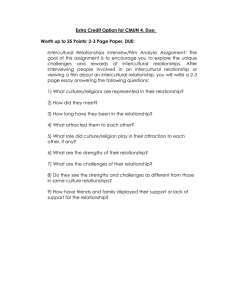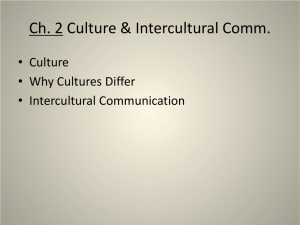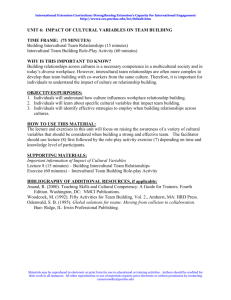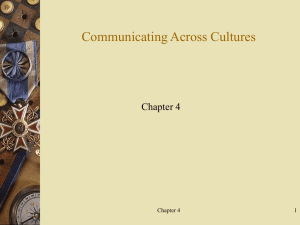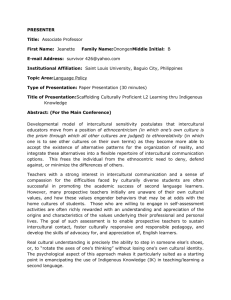Limitations of the Golden Rule April 2012
advertisement
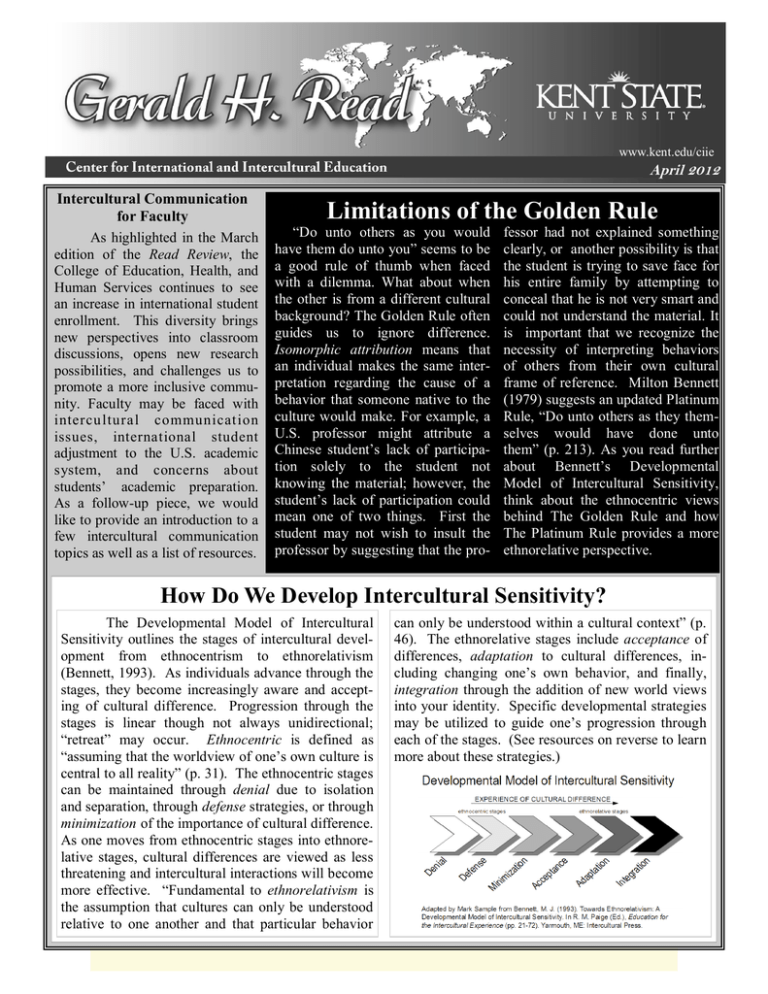
www.kent.edu/ciie April 2012 Intercultural Communication for Faculty As highlighted in the March edition of the Read Review, the College of Education, Health, and Human Services continues to see an increase in international student enrollment. This diversity brings new perspectives into classroom discussions, opens new research possibilities, and challenges us to promote a more inclusive community. Faculty may be faced with intercu ltural communication issues, international student adjustment to the U.S. academic system, and concerns about students’ academic preparation. As a follow-up piece, we would like to provide an introduction to a few intercultural communication topics as well as a list of resources. Limitations of the Golden Rule “Do unto others as you would have them do unto you” seems to be a good rule of thumb when faced with a dilemma. What about when the other is from a different cultural background? The Golden Rule often guides us to ignore difference. Isomorphic attribution means that an individual makes the same interpretation regarding the cause of a behavior that someone native to the culture would make. For example, a U.S. professor might attribute a Chinese student’s lack of participation solely to the student not knowing the material; however, the student’s lack of participation could mean one of two things. First the student may not wish to insult the professor by suggesting that the pro- fessor had not explained something clearly, or another possibility is that the student is trying to save face for his entire family by attempting to conceal that he is not very smart and could not understand the material. It is important that we recognize the necessity of interpreting behaviors of others from their own cultural frame of reference. Milton Bennett (1979) suggests an updated Platinum Rule, “Do unto others as they themselves would have done unto them” (p. 213). As you read further about Bennett’s Developmental Model of Intercultural Sensitivity, think about the ethnocentric views behind The Golden Rule and how The Platinum Rule provides a more ethnorelative perspective. How Do We Develop Intercultural Sensitivity? The Developmental Model of Intercultural Sensitivity outlines the stages of intercultural development from ethnocentrism to ethnorelativism (Bennett, 1993). As individuals advance through the stages, they become increasingly aware and accepting of cultural difference. Progression through the stages is linear though not always unidirectional; “retreat” may occur. Ethnocentric is defined as “assuming that the worldview of one’s own culture is central to all reality” (p. 31). The ethnocentric stages can be maintained through denial due to isolation and separation, through defense strategies, or through minimization of the importance of cultural difference. As one moves from ethnocentric stages into ethnorelative stages, cultural differences are viewed as less threatening and intercultural interactions will become more effective. “Fundamental to ethnorelativism is the assumption that cultures can only be understood relative to one another and that particular behavior can only be understood within a cultural context” (p. 46). The ethnorelative stages include acceptance of differences, adaptation to cultural differences, including changing one’s own behavior, and finally, integration through the addition of new world views into your identity. Specific developmental strategies may be utilized to guide one’s progression through each of the stages. (See resources on reverse to learn more about these strategies.) Power Distance and Teacher-Student Interactions The cultural value of power distance can be encountered in teacher-student interactions. Perceptions of the teacher’s role vary around the world and often reflect the underlying power distance cultural value of the larger society (George, 1994). Power distance is on a spectrum from large power distance to small power distance with world cultures distributed in between (Hofstede, 1991). Cultures on the large power distance end of the spectrum tend to accept “unequal power distributions, hierarchical rights, asymmetrical role relations, and rewards and punishments on the basis of age, rank, status, title, and seniority” (Ting -Toomey & Chung, 2005, p. 382). On the other end of the spectrum, cultures with small power distance value “equal power distributions, equal rights and relations, and equitable rewards and punishments based on performance” (Ting-Toomey & Chung, 2005, p. 386). U.S. faculty members may notice a level of deference from international students. In many Asian and Arab cultures the professor is seen as the authority figure, so there are greater expectations of formality and distance. For example, “Arab and Asian students were surprised at the informal way American teachers dress and sit in the classroom” (George, 1994, p. 7). In the school or university setting, this power distance can be displayed by the roles of teachers and students. In cultures with large power distances, the teacher often takes the role of lecturer; while in cultures with small power distances, the teachers and students may exchange ideas and feedback. To demonstrate respect for the teacher as an authority figure, students may be less likely to question the faculty. Students may be more accustomed to received knowledge rather than constructed knowledge, so students from cultures with a strong teacher authority may encounter challenges with ambiguous directions, and individually choosing topics. Intercultural Communication Print and Online Resources Bennett, M. J. (1979). Overcoming the golden rule: Sympathy and empathy. In D. Nimmo (Ed.), Communication Yearbook 3. Washington, DC: International Communication Association. Bennett, M. J. (1993). Towards Ethnorelativism: A developmental model of intercultural sensitivity. In M. Paige (Ed.), Education for the intercultural experience (pp.21-71). Yarmouth, ME: Intercultural Press. George, P. G. (1995). College teaching abroad: A handbook of strategies for successful cross-cultural ex changes. Boston: Allyn and Bacon. Hall, E. T. (1959). The silent language. New York: Doubleday. Hofstede, G. (1991). Cultures and organizations: Software of the mind. London: McGraw-Hill. Ting-Toomey, S. & Chung, L. C. (2005). Understanding intercultural communication. NewYork: Oxford University Press. The Intercultural Communication Institute (ICI) offers resources for intercultural, cross-cultural, multicultural, international, diversity training, and education. Check out the ICI bibliography webpage for a more extensive list of references. http://www.intercultural.org/bib.php For a comprehensive list of Intercultural Training and Assessment Tools, check out this ICI webpage. http://www.intercultural.org/tools.php Global Learning Scholars in EHHS Revise Undergraduate Courses to Incorporate Global Learning Outcomes By Joanne Arhar, Associate Dean and Professor, EHHS As part of our effort to accomplish one of the key points in the College of EHHS’ strategic plan to internationalize the undergraduate curriculum, undergraduate faculty ranked from most to least important a set of global learning outcomes that has been developed by the American Council on Education (ACE). In the fall of 2010 the Global Learning Study group tabulated the results and determined that the following outcomes for our undergraduate students: Knowledge: Understands his/her culture in global and comparative context (recognizes that his/her culture is one of many diverse cultures & that alternative perceptions & behaviors may be based in cultural differences). Skills: Adapts his/her behavior to interact effectively with those who are different. Uses knowledge, diverse culture frames of reference, and alternative perspectives to think critically and solve problems Interprets issues & situations from more than one culture. Attitude: Is willing to learn from others who are culturally different from him/herself. Since the adoption of these learning outcomes, eight faculty in EHHS have adapted one of their courses to incorporate these outcomes and assessments to measure them. The faculty, their programs and courses are as follows: Faculty Karen Lowry-Gordon Maureen Blankenmeyer Mary Ann Devine Program Nutrition and Dietetics Jennifer Fisette Human Development and Family Studies Recreation, Park, and Tourism Management Physical Education Deb Clark Cultural Foundations Chia-Ling Kuo Instructional Technology Janice Kroeger Early Childhood Education Joanne Dowdy Literacy Education Course Being Revised NUTR 5/43016 Cultural Aspects of Food, Nutrition and Health (required of all majors) HDFS 44030 Family Life Education Methodology (required for all Family Life Education Concentrations) RPTM 36040 Inclusion of People with Disabilities in Leisure Services (required of all majors and minors in RPTM) PEP 15010 Introduction to Physical Education, Fitness, & Sport (required for all PE Teacher Education students) CULT 29535 Education in a Democratic Society (required for all teacher education students) ITEC 19525 Educational Technology (required for all Education Majors) ECED 40142 Home, School, Community Partnerships (required by all licensure PreK-3rd grade seeking UG and MAT graduate degrees) C&I 47330 Reading and Writing in Adolescence and Adulthood (required for all Adolescent to Young Adult Majors) Each faculty selected a course that had the potential to reach a large number of students. So as the chart indicates, selected courses are required for all students in the major and in some cases, the minor as well. They have piloted the revised course and have given reports of their work to the Advisory Board for the Read Center for International and Intercultural Education as well as teacher educators from across Ohio at the spring conference of the Ohio Confederation of Colleges for Teacher Education. Their work received funding from two sources. The five teacher education faculty are part of a project funded by the Longview Foundation. The five faculty from EHHS meet regularly with five faculty from the University of Akron and five faculty from Miami University. The goal of that project is to internationalize the teacher education curriculum at each institution by supporting the professional development of the global learning scholars. This project is complete in December 2012, and additional funding is being sought for more teacher education faculty to participate in this program. The other source of funding is from the Provost’s Innovative Curriculum Project. The Global Learning Study group consisting of faculty from all four Schools, the Library/Media Center, and the Office of Global Education submitted a proposal to the Provost’s grant and were awarded funding for faculty development in 2010 and again in 2012. The new group of scholars, one from each School, are in the process of being selected. One of the unique aspects of the Global Learning Study group is that current scholars mentor new scholars. During the fall, each of the scholars will give a brief presentation to their colleagues in their program and School. This will help us to reach more interested faculty with the goal of having all students in each program demonstrate the knowledge, skills, and dispositions that are outlined in the College of EHHS’ Global Learning Outcomes by the time they graduate. For further information about joining the Global Learning Study Group contact Mary Ann Devine, Maureen Blankenmeyer or Averil McLelland. For more information about the Longview Grant, contact Joanne Arhar.
